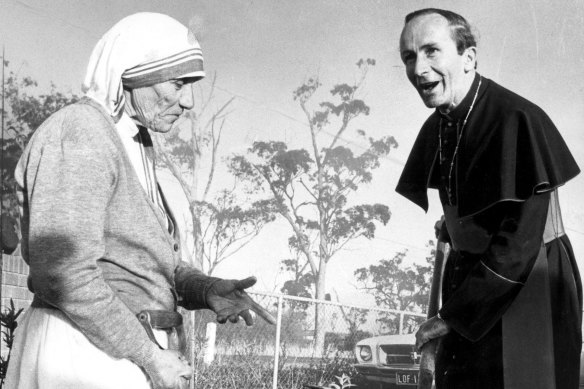First published in The Age on September 7, 1997
Death of a Saint
FOR the second time within a week, the world was in mourning last night. Mother Teresa, the saint of the streets, died early yesterday morning. She was 87.
Mother Teresa in Australia with Catholic Archbishop Little to open the Corpus Christi Centre in Greenvale with a tree planting ceremony.Credit:The Age Archives
Within an hour of her death from heart failure, thousands of people converged on a narrow alleyway in Calcutta — the headquarters of the Missionaries of Charity. There, they bid farewell to a woman whose concern and care for the poor and wretched earned her the Nobel Peace Prize in 1979.
The tiny but indomitable nun she was 147 centimetres tall — had been ill for two years. She had been in and out of hospital with a series of cardiac problems complicated by pneumonia.
Pope John Paul II reacted with “profound pain” and “great emotion” when told of the death.
Cardinal Basil Hume, leader of the Roman Catholic Church in England and Wales, was told of her death a few minutes before he conducted a Requiem Mass for Princess Diana. “It is rather lovely to think that Mother Teresa, who was very friendly with Princess Diana, should have gone so soon to join her,” he said. “Both in different ways had served people in need.”
The daughter of an Albanian builder, Mother Teresa moved to Calcutta in 1929. In the late 1940s she found a woman beggar lying on a street covered in flies and rats. She stayed with the woman until she died and from there more than 50 years of caring for the poor began.
She left behind two saris and the bucket she used to wash in. But the order she founded now has 4000 nuns running orphanages, homes for the poor, Aids hospices and other charity centres across the world. The order feeds half a million people, teaches 20,000 slum children and cares for 90,000 lepers.
Mother Teresa’s Service held at the All Saint’s Church in Fitzroy.Credit:Jason South
First published in The Age on September 7, 1997
Timing of death not lost on her order
MOTHER Teresa would probably be pleased with the timing of her death. While the world’s focus was on another bereavement, she was able to die without fuss.
At the Melbourne branch of her order, the Missionary Sisters of Charity, there are smiles and laughter. A strange event, considering it was the day of the death of their founder.
But look closely and there is a quivering of lips, a slight closing of eyelids and many long-held breaths. For these women, it is a day of sorrow and joy.
They explain it easily in terms of their faith: Mother Teresa has gone to where she has always wanted to be — she is now with Jesus.
The significance of the timing of her death is not lost on the community. Sister Soledad holds up a handmade card left on their doorstep when the news was announced.
It reads: ″Mother Teresa, we loved you. This week we have lost two great women. But what is important, and will always remain, is to love – Denise.”
Born in the Philippines and in Australia for 10 years, Sister Soledad is praying in the order’s chapel, a converted front room in the Edwardian house that serves as their convent in Gore Street, Fitzroy.
“Mother Teresa didn’t like all the attention she got, so I think she would be happy to die when the world’s attention was busy with Diana,” Sister Soledad said.
The convent’s superior. Sister Joachina, reflects on the emotional conflict: “We are sorry that we have lost our foundress, but we are happy she is with Jesus.”
Mother Teresa’s death fell just days short of the order’s most important date, Inspiration Day, the 51st anniversary of their foundation.
In Melbourne, the nuns run two centres to help women and men who have suffered a raw deal in life.
The House of Compassion next to the convent acts as an emergency centre and refuge for victims of domestic violence.
In neighbouring George Street, the House of Mercy helps homeless men, sheltering 12 each night and feeding 100.
Sister Joachina, who has been with the order for 15 years, can appreciate the impact of poverty because she came from a life where she often saw wealth and comfort.
Before becoming a nun she had run restaurants and worked in city hotels, including the Hilton.
“Our foundress taught us that it was a great privilege to work with the poor, to know that no one is better except by the grace of God.”
She also taught us that poverty is not just a lack of worldly goods, it can also be loneliness. I think of a man who is not so poor that he doesn’t have a car, but he drives from Thomastown every night to our soup kitchen. He does it mainly for companionship because he is desperately lonely.”
Most Viewed in National
From our partners
Source: Read Full Article

